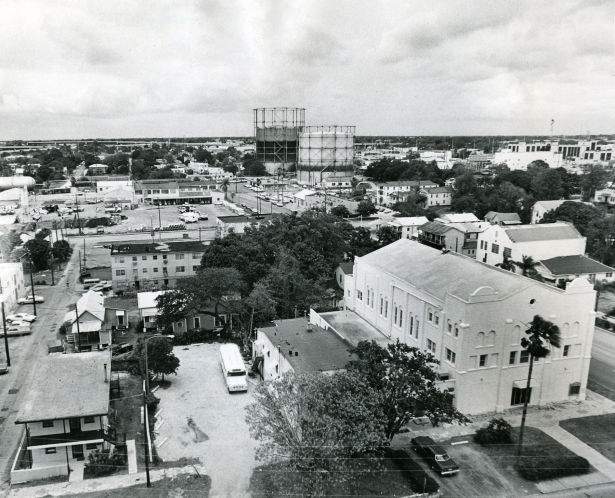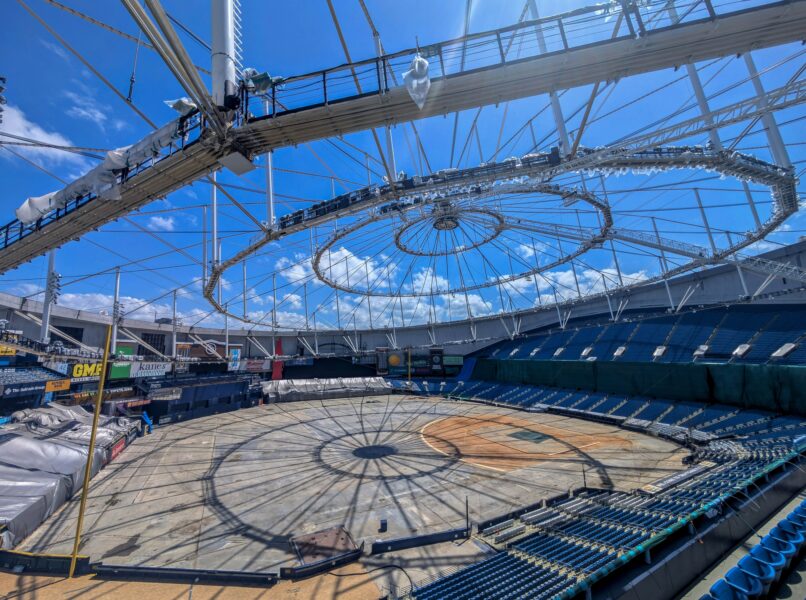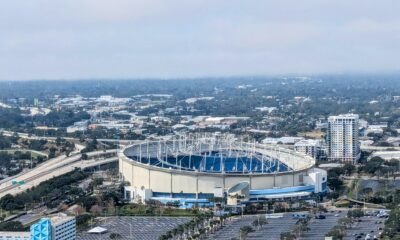Thrive
Tropicana Field came at a cost to the Black community

New plans are afoot for the sprawling Tropicana Field site, where Black families once lived and from which they were displaced.
Little has gone smoothly for the site since more than 2,000 Black residents were uprooted, along with their places of worship and businesses.
Talk of redeveloping the community of small Black neighborhoods, spread across 66 acres in what was called the Gas Plant area, dates back to 1973. The City Council subsequently declared the area a place of “slum and blight” and promised residents better housing and light industry that would yield precious jobs.
It never happened.
The 1980s brought a change of plans. City leaders decided to build a stadium on the land, intent on luring St. Petersburg’s very own Major League Baseball team. Environmental issues emerged at the construction site. The two gas storage tanks that gave the area its name, and in whose shadow Black people had lived for decades, had contaminated the soil. Millions were spent on clean-up.
More recently, the Tampa Bay Times reported that there might be graves at the Tropicana site.
While the grand opening of the new Florida Suncoast Dome was celebrated on Feb. 28, 1990, it would be a while before there was a home team. The Tampa Bay Devil Rays – now the Tampa Bay Rays – played their first game in the stadium on March 31, 1998.
Now the team wants a new home – probably not in St. Pete – and would like to split their games between St. Petersburg and Montreal. And the city and the Rays are quarreling about redevelopment of the Tropicana site. Mayor Rick Kriseman has said that the team, whose lease with the city ends in 2027, is demanding a larger share of the development rights. He is adamant that the site must deliver justice and opportunity for all the people of St. Petersburg.
That’s good news for the Black community, which has felt ill-used by the original stadium deal.
Gwendolyn Reese, president of the African American Heritage Association of St. Petersburg, is on the panel that is helping to evaluate the seven redevelopment proposals. Reese told me she’s focusing on how each developer plans to preserve the history and tell the story of the African-American community, and how that history will be incorporated throughout the project. She’s also evaluating the proposals “through an equity and inclusivity lens.”
Reese disputes the “slum and blight” characterization of the now demolished Gas Plant area. “It wasn’t all rundown. I lived on Sugar Hill, which was on Fifth Avenue,” she said, going on to mention the admirable homes of Dr. James Ponder, the city’s first black physician, the McRae family and Mr. Polk, a former Gibbs High School principal.
“A lot of people owned their homes and they were quite proud of them,” she said. “We had businesses galore. It was not all ramshackle and it was not all poor housing. Miss Thelma had the prettiest yard. It was a mixed-income neighborhood, because redlining meant we all had to live in the same neighborhood.”
Reese also spoke of Louise W. “Mama Louise” Macon, who died in 1995, at age 81, and owned the last house that was demolished for stadium parking. She had been reluctant to leave the home in which she had lived for 37 years.
And there was Delores Jackson, who worked tirelessly to try to save the Laurel Park public housing complex that was razed for stadium parking and one of properties that helped expand the stadium site to its current 86 acres.
The issue of Tropicana Field continues to be a sensitive one. Two years ago, Rick Mussett, St. Petersburg’s former development administrator, discussed the evolution of the project with me. “I wanted the record to be correct, in terms of how it happened, who handled it,” he said this week. “Some people did feel hurt, having to give up their homes.”
Mussett, who helped to bring baseball to the city and served as the city’s liaison with the Rays until his retirement in 2014, explained that while the Pinellas Sports Authority wanted a stadium in the Gateway area, the council and city manager were not in favor of such a plan. “The downtown area was in very bad shape,” he said. “They thought this would have been the death knell for downtown.”
Downtown sites, including the Albert Whited Airport and Al Lang Stadium, were considered and rejected. In the end, he said, the Gas Plant site was seen as suitable.
“It looks like now, hopefully, we can do something to help the African-American community. It’s been so long,” said Mussett, who, after retirement, accepted a one-year assignment from Kriseman to head the Baseball Forever project to help keep the Rays on this side of the bay. “The city has an opportunity to have a real good mixed-use development project. Even if the Rays stay, we can have our cake and eat it too.”
Reese is hopeful, too. “I do believe that the mayor is very, very sincere in what he is putting forth, wanting to see equity from the proposals to the ribbon cutting, she said. “You can’t make up for what happened, but it’s an opportunity to rectify the promises that were made and not kept to the people most impacted.”
Kriseman’s term ends next January. One of the candidates vying to be the city’s next mayor is former Pinellas County Commissioner Ken Welch. His father, David Welch, was the lone African American on the City Council in 1982, when the stadium was proposed for the Gas Plant site. The idea upset him.
“When you went into this area and moved out all the people, you said you were going to rehabilitate and create light industry and create jobs,” he said, according to the Tampa Bay Times. “You have a moral obligation to those individuals who were moved out for what you have told them.”
But he ended up voting with his colleagues for the stadium. He explained later, the Times said, that private developers had expressed no interest in redeveloping the Gas Plant area.
It might well be that this time, the community that was discounted and pushed aside for baseball will get the respect and compensation long ago denied.






Ann Neelen
February 2, 2022at6:21 pm
I grew up in the St. Petersburg area my whole life. I cannot tell you how sad I was for the people that were displaced just to build a stadium. I think of those people everytime I drive by the stadium. They are sad thoughts of how many people suffered for people who make millions and don’t understand the issues of the people who were left homeless and destitute just so “Baseball could come to Tampa Bay “. Such a tragic story ..
Bad juju I call it that’s what has followed that stadium since it opened. You cannot do harm to your fellow man and think you don’t have to pay the price for your actions.
DOUGLAS HANSEN
February 5, 2021at5:34 pm
Very biased article. I don’t disagree with the breakup of the Black community and need to restore equity, but to say the Rays aren’t interested in St. Pete is not true, and I would hope a smaller stadium site along with restoration of what was lost can happen.